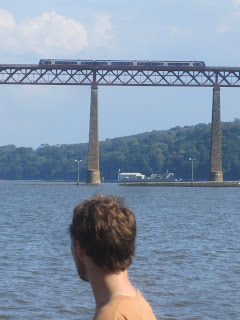Well, the majority of the supermarkets are reasonably small, 'express' sized supermarkets. There are probably 3 or 4 really big supermarkets. The small ones have an appalling selection of foods. I happen to live about a 15 minute walk from a nice big one, so that's where I have started going. Tesco's, it's called.
So, first things first.
-There is an extreme lack of fresh food. I'm talking produce, vegetables, meat, and fish.
-An incredibly high percentage of the foods are packaged.
If I want to buy tomatoes, they are not usually loose (only at the BIG market is there a small selection of loose, regular old tomatoes). Then, most times, they sell tomatoes in a plastic tin. Sometimes the tin is then covered in the outside in plastic. This is a theme that is repeated ALL over the produce and vegetable aisle. Everything is covered in plastic. Plastic here, plastic there. When you can get loose items, it is of the staples. Today, I got a few loose basic tomatoes, some loose red onions, even loose garlic and loose avocados. There is no such thing as a giant pile of potatoes, a giant pile of apples, a giant pile of anything. Even when loose, they come individually tagged and in crates. But the amount of plastic seen in the fruits and vegetable sections is overwhelming. In the express stores, forget about buying anything that is not packaged. On the bright side, at least some of the supermarkets charge you 10 pence for a plastic bag.
Another oddity is that produce that can be ripened on the counter usually comes unripened. I suppose this is because nearly all the produce is imported and it increases the shelf life if they pick it early. Usually, the plastic wrap will say where it is from. My cheery tomatoes are from Morocco. My asparagus is from Peru. My red pepper is from Italy. My orange is from South Africa. Surprisingly, my green onions and broccoli are from Scotland. One thing you CAN get from Scotlan in bulk, for very cheap, of course, is white potatoes.
I recently read an article that, not surprisingly, most of the surface of the UK has been converted for agricultural use. So, of course, there is an extreme lack of fruits and vegetables, and what they have is mostly imported. The article also said that there really are only about 6 varieties of apples that they grow in the UK. I think that surprised me.
Then, there is a big freezer section, 2 or 3 rows. The baked bean section is great, it is HUGE, the largest I have ever seen my entire life. Lots of human gases must be produced from such a high baked bean consumption. Then, say you are looking for black beans... first you need to look for baked beans. Then slide over 3 or 4 columns and you are in the 'pulse' section, where all the other 'beans' are. Next time I am lost I'll remember to ask the clerk 'Can you please direct me to the pulse section please?'
The breakfast sausage section is massive. You can get them in the traditional form, or squares. And they are CHEAP. Large selection of bacon, too.
Forget about much fresh meat, as in, the butcher just cut it 'fresh'. Just go straight to the refrigerated aisle and pick up a packet. I guess if you want good, fresh meat, go to a butcher.
The selection of frozen and refrigerated prepared foods is massive. All sorts of meat pies. Haggis. Things you couldn't even think of.
On the other hand, I started a trend of buying a few new, random food items each week. If you can't tell from the food blogs, I'm having a lot of fun doing this. There are many things I haven't seen before, which is great, except my heart probably doesn't like, for example, today's combination of pork pies, Haggis, Irn Bru, and Mulligatawny soup that I picked up... it'll just have to work a little harder until I leave:
Irn Bru. A Super Scottish drink they claim cures hangovers. Loaded up with caffeine and sugar. Tasted like any other energy drink. They say it competes with Coke and Pepsi here:

MacsWeen Haggis. George said it was pretty good Haggis, even for being sold in the supermarket, so I went for it:

Mulligatawny soup. Never seen it in a US supermarket (probably wasn't looking). Wikipedia tells me its some Indian-British originated soup with curry flavorings.

'Melton Mowbray Pork Pies'. Sounds like a heart attack and artery clogger. I reckon I'll have a go (reckon that it might be my new favorite word, by the way). Melton Mowbray is a city in England famous for its pies (NOT fruit pies!)
























































